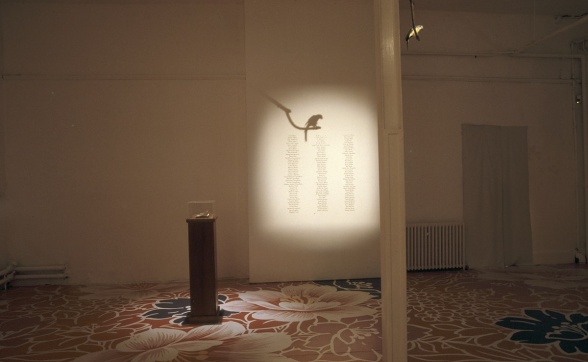Michael Ming Hong Lin
Michael Ming Hong Lin, Bibliotherapy meets Robinson Crusoe (installation view), 2002
Michael Lin’s (b. 1964, Tokyo) site-specific painted walls and floors establish situations that have a direct relationship not only formally to the interior of the building in which they are sited, but also with their audience. Lin’s painted floors are there to be walked on, to be used as sites for socialising and for pausing to enjoy an aesthetic experience. Although Lin eschews the idea that his paintings are primarily concerned with a fusion between Asia and the West, they convey an awareness of the paradoxes that exist between the two: duality is ever present in his work. Dialogues between ornament and architecture, motif and ground, tradition and modernity, local and global are all referenced in his work within a theoretical framework that mediates the possibilities of painting and the reception of art.
Fellow artist Rémy Markowitsch (b.1957, Zurich) has consistently employed books as the point of departure for an art practice that analyses the language of the publishing process (mechanical reproduction) in order to make artworks that give an account of the complexities of reading and looking. Bibliotherapy is the vehicle he uses to construct a strategy that enables him to express ideas about literature and its logical and natural connection with visual art. Bibliotherapy is an evolving work. It existed before Liverpool Biennial in a different form and will continue to develop and change in the future.
In International 2002, Rémy Markowitsch and Michael Ming Hong Lin collaborated and created a three part installation. The first was the reading of Robinson Crusoe. Markowitsch selected Daniel Defoe’s novel for Liverpool because ‘it is deeply rooted in English culture and society. It is not only a timeless adventure story, but also one of the most significant representations of Utopia in world literature’. Markowitsch presented Robinson Crusoe in Liverpool as a series of readings. Shot on video, the complete reading lasted for about fourteen hours during which the entire length of the book was read in short snippets by many different people from across the UK to reflect the diversity of contemporary British society.
Standing on Michael Lin’s painted floor is the second element of Bibliotherapy: BonsaiPotato. This illuminated monumental sculpture, which borrowed the form of a European standard potato, was a ‘humorous, pseudo-scientific, quasi-therapeutic exeriment, in which ideas of light, energy and nutrition meet, interlock and undergo revision’. It stood upon a table at which visitors could sit to read, illuminated by its light. This ‘food’ illuminated the spiritual food of the books on the table. Its bonsai nature – i.e. its potential as a source of reflection – conjoined with Lin’s floor (the third element) and created a pastiche of orientalism and the exoticising of domestic interiors. In the theatre of social exchange that Markowitsch and Lin worked together to create, everything was a copy
Michael Ming Hong Lin at Liverpool Biennial 2002
Bibliotherapy meets Robinson Crusoe, 2002
Installation
Commissioned by Henry Moore Foundation Contemporary Projects
Exhibited at Pleasant Street Board School
Supported by
Pro Helvetica
Arts Council of Switzerland
Visiting Arts
Liverpool Biennial
55 New Bird Street
Liverpool L1 0BW
- T +44 (0)151 709 7444
- info@biennial.com
Liverpool Biennial is funded by
Founding Supporter
James Moores
